Before becoming a marketer, Brian sold insurance.
Alfred was in the army.
Arielle was a health coach.
I was a sports reporter.
And now look at us! We’re a team of eight Buffer marketers, with vastly distinct backgrounds and educations, who collectively bring in 20,000 Buffer signups each week. Many of us fell into marketing, accidentally or on purpose. We’ve been learning as we go.
And where exactly are we headed?
Good question! We benefit a lot from free marketing courses and great educational content. However, it’s not often the case that we have a specific vision for the skills we gain or the path we’re on.
Does this resonate with your marketing experience? Do you have an easy way to answer, “What does it mean when we’re asked to become ‘T-shaped’ marketers?”
Since I’ve stepped into a leadership role on the marketing team, I’ve become the one posing the T-shaped question to others, so it seemed time to figure out what T-shaped means for us at Buffer and what it might mean for digital marketers beyond Buffer. Here’s what I came up with. I’d love your thoughts!
(Caveat: This is all verrrry much specific to the way we do marketing at Buffer. YMMV, though hopefully it’s a good starting point for you and your team. Feel free to copy and edit!)
The Diagram of a T-Shaped Marketer at Buffer
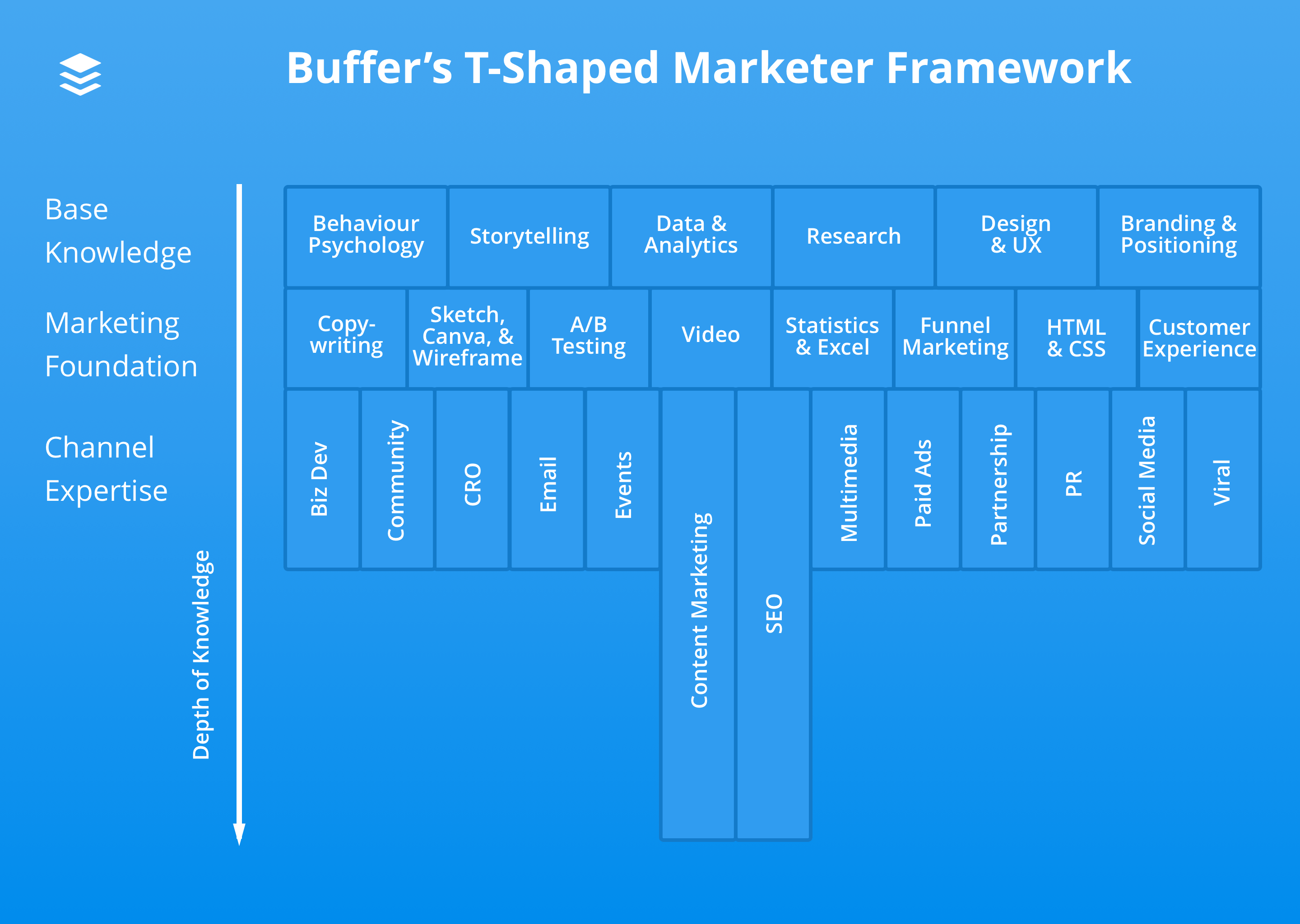
This is how we view a T-shaped marketer at Buffer. Feel free to grab a download of the Sketch file or Canva template we used to build this, if you’d like to customize it for your company.
Generally-speaking, everyone on the Buffer marketing team will have all the base knowledge and marketing foundation skills listed in the diagram; plus, each teammate will have chosen at least one main channel in which they are an expert.
Much more on this below, but first, I’d love to explain more about the idea of T-shaped people in general.
The concept of a T-shaped person comes from the world of hiring, and it describes the abilities that someone brings to a job — their depth and breadth of ability. The vertical, up-and-down stem of the “T” represents one’s depth in one or more areas, and the horizontal, side-to-side stem of the “T” represents one’s breadth.
The vertical bar on the T represents the depth of related skills and expertise in a single field, whereas the horizontal bar is the ability to collaborate across disciplines with experts in other areas and to apply knowledge in areas of expertise other than one’s own.
Often times the word “generalist” is used to apply to a T-shaped person; though in our case at Buffer, a generalist would be someone with a relatively short vertical T stem and a very broad horizontal T stem.
Our T-shaped marketer diagram relies heavily on the foundation that Brian Balfour laid with his T-shaped description back in 2014. In his post on becoming a customer acquisition expert, Brian laid out a blueprint for how someone could grow their marketing skills. Brian based his research on an article from Distilled. Both Brian’s and Distilled’s articles are great places to start if you’re keen to learn more about T-shaped marketers.
- How To Become A Customer Acquisition Expert by Brian Balfour
- Building a T-Shaped Web Marketing Skill Set by Distilled
The 3 Components of a T-Shaped Marketer
As you can see in the diagram, the abilities of a T-shaped marketer fit into three different components:
- Base Knowledge
- Marketing Foundation
- Channel Expertise

Base knowledge is the non-marketing-specific areas that will suit you well no matter your job.
In theory, anyone who applies for a marketing role at Buffer would have competence with these abilities, and anyone on the current marketing team would focus on leveling up in these areas first and foremost. These basic abilities really do trickle down and inform the other skills you need.
Everyone on the marketing team should feel comfortable with all base knowledge boxes.
Marketing foundation is the marketing-specific subjects that are useful across most all marketing channels.
Our list is an incomplete one. For instance, Brian Balfour’s 2014 model includes conversion rate optimization (CRO) as a foundational skill. We don’t expect everyone on the team to have foundational skills in CRO (in fact, we view it as its own channel in which you can become an expert). Also, Brian mentions database querying. That’s not as important to us. The marketing foundation at your company is likely to entail some unique skills of its own.
Everyone on the marketing team should feel comfortable with all marketing foundation boxes.
Channel expertise refers to audience and acquisition channels.
There are soooo many of these, and we’re constantly finding new ones. For instance, product marketing wasn’t a channel for us a couple years ago. Now, it would serve us well. And on the flip side, there are areas, like sales, that we don’t do at Buffer.
The idea with channel expertise is that someone will have one or more channels for which they have great depth of knowledge.
When a T looks like an M: Variety within channel expertise
As you might experience for yourself, it’s not always the case that your skills fit a neat and tidy T shape, especially as you keep evolving as a marketer.
The T shape is definitely just a framework. On our team, we have a variety of people with a variety of skills, all at different depth and breadth.
In some cases, the T might have three vertical stems of different lengths. (An “M.”)
For others, it might have one really, really deep stem.
If it helps, here’s a quick view of how our current team looks within the T-shaped marketer model.
Alfred, Content Crafter
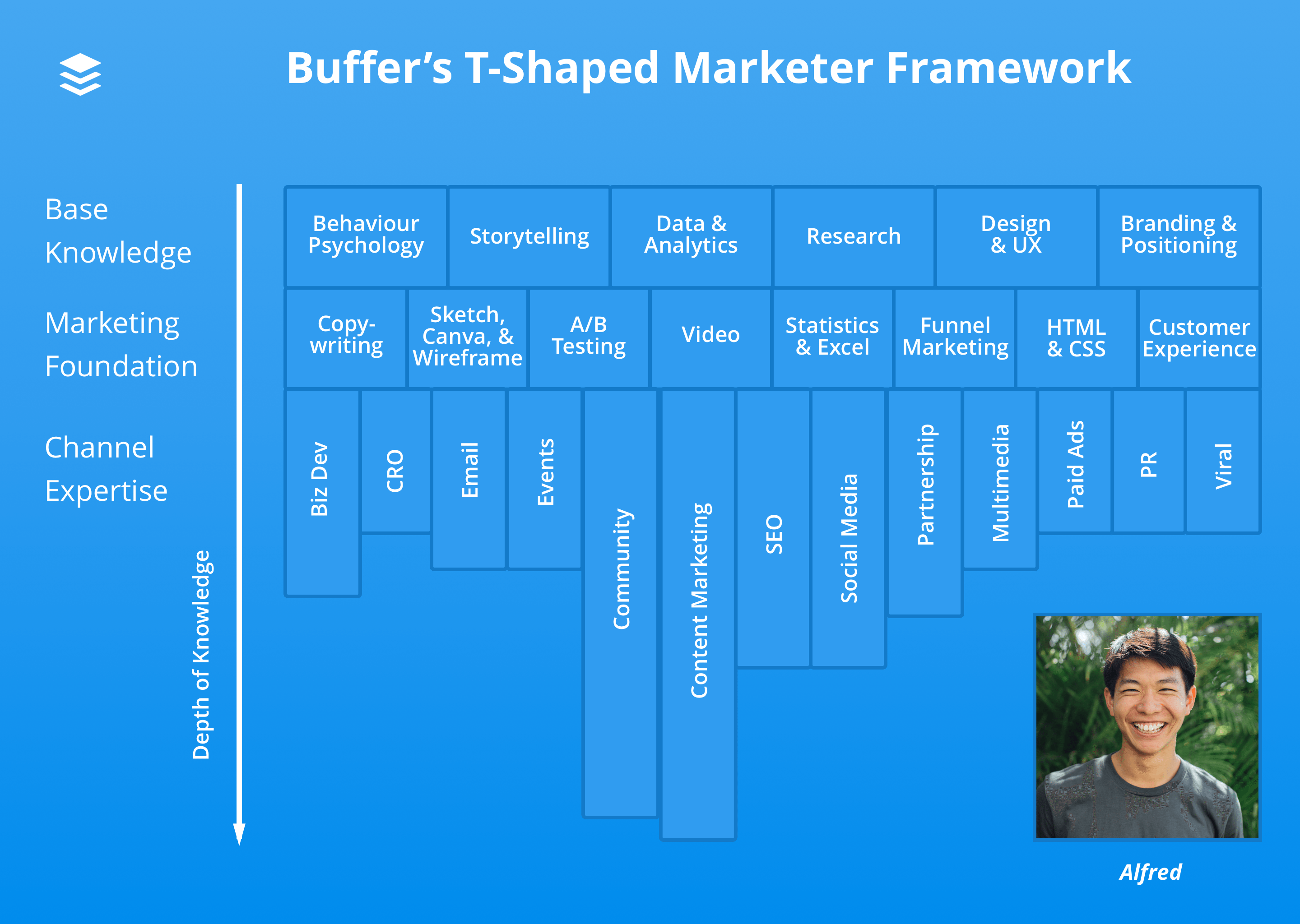
Arielle, Community Strategist
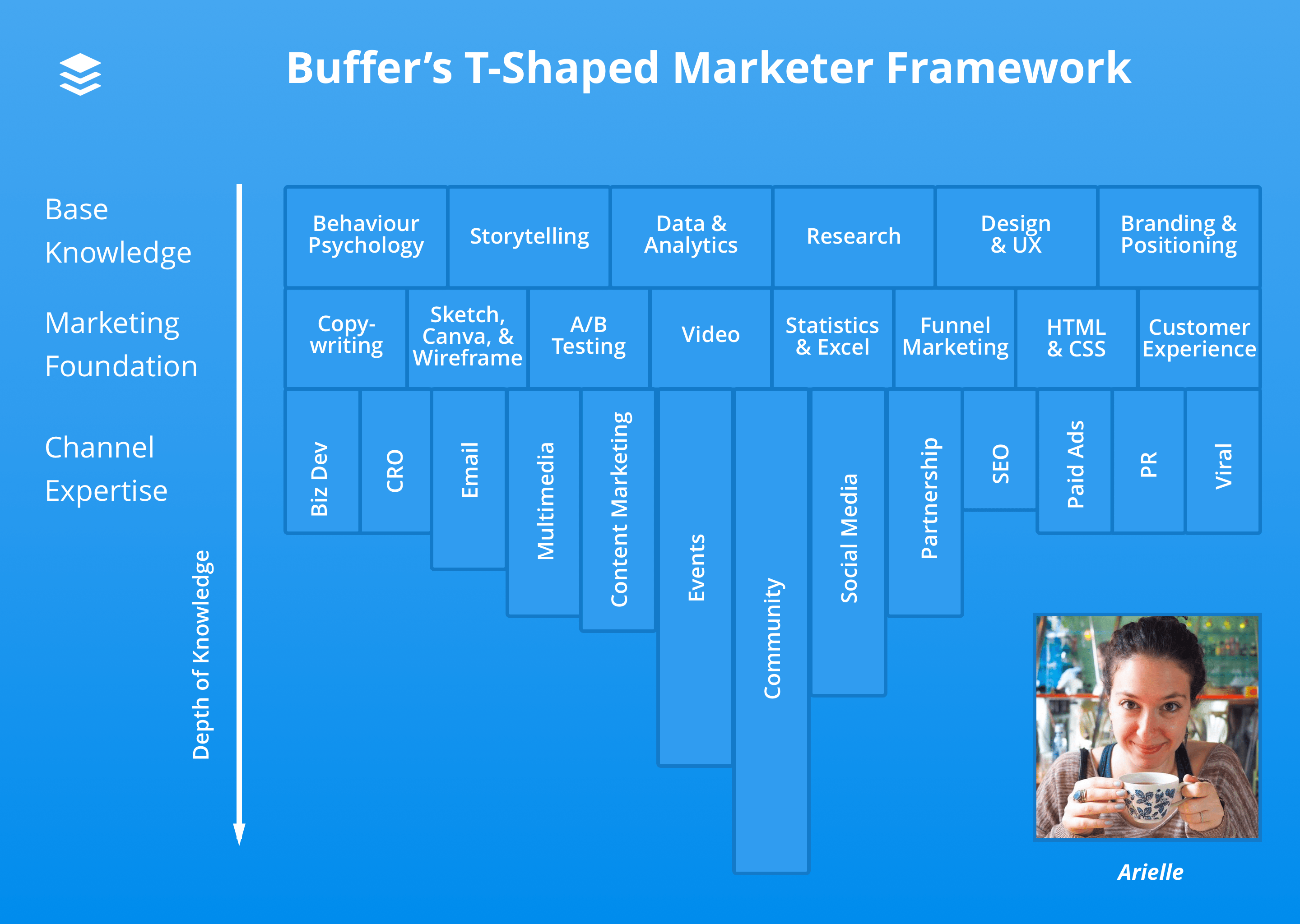
Ash, Managing Editor
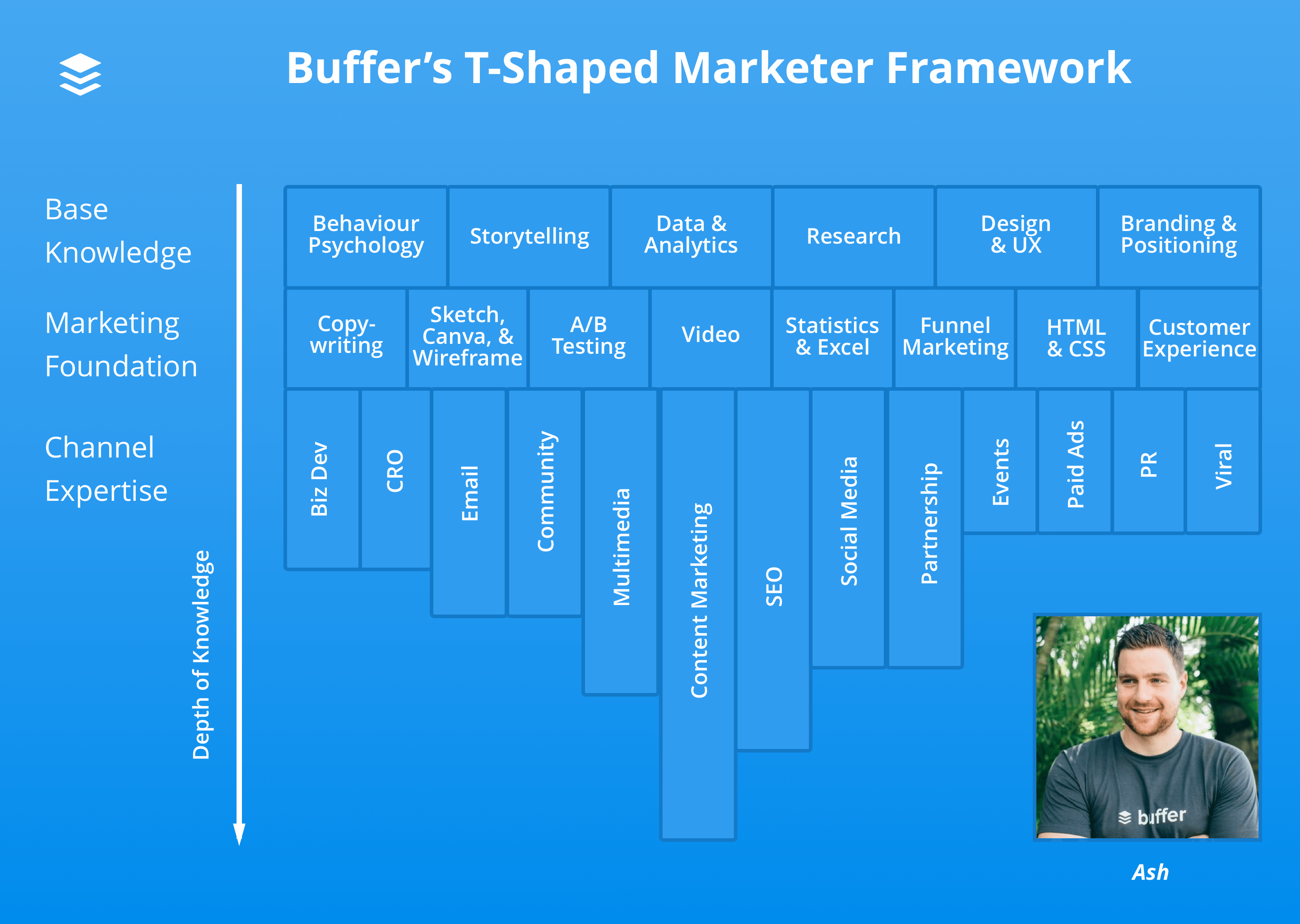
Bonnie, Loyalty Marketer
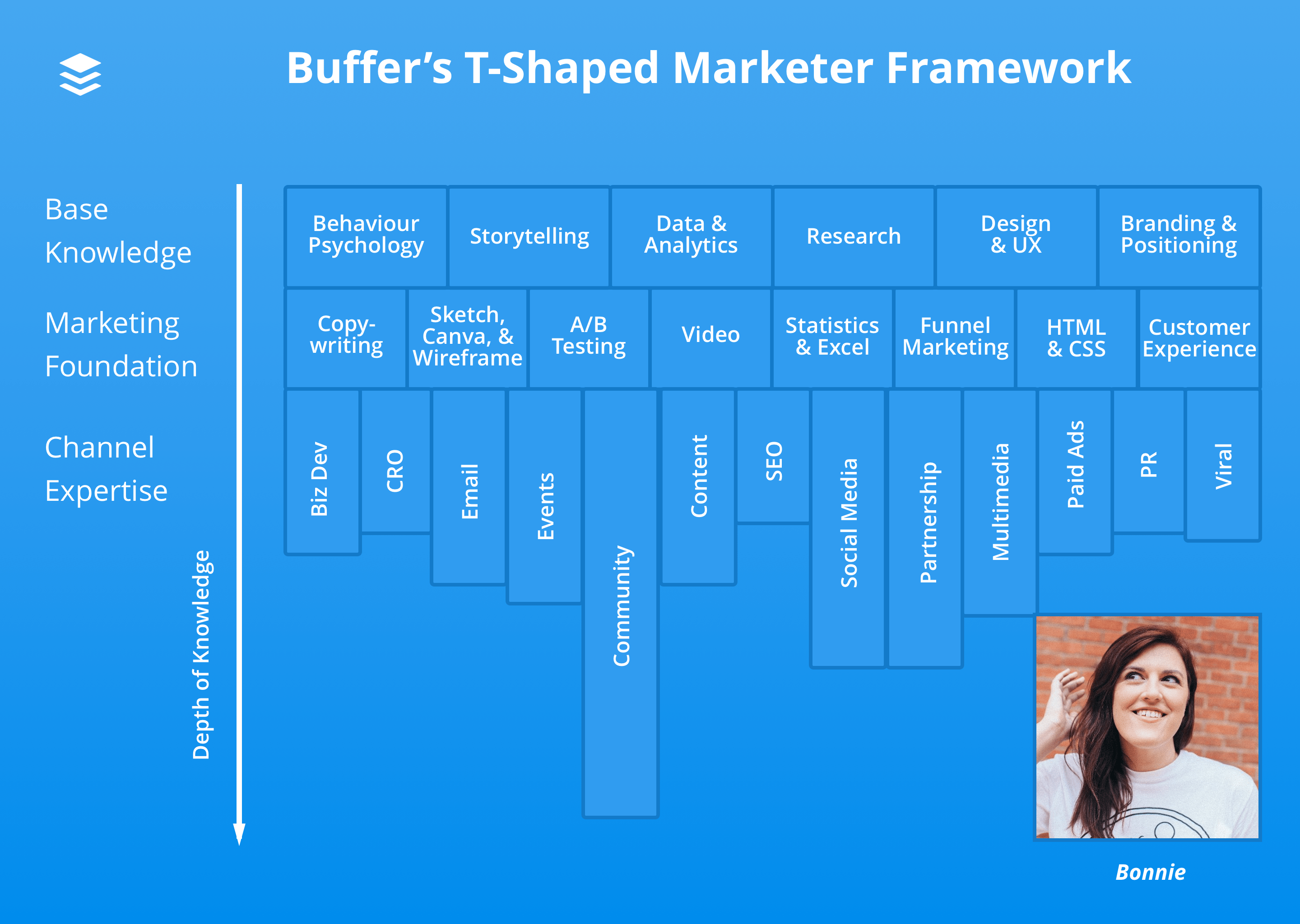
Brian, Digital Marketing Strategist
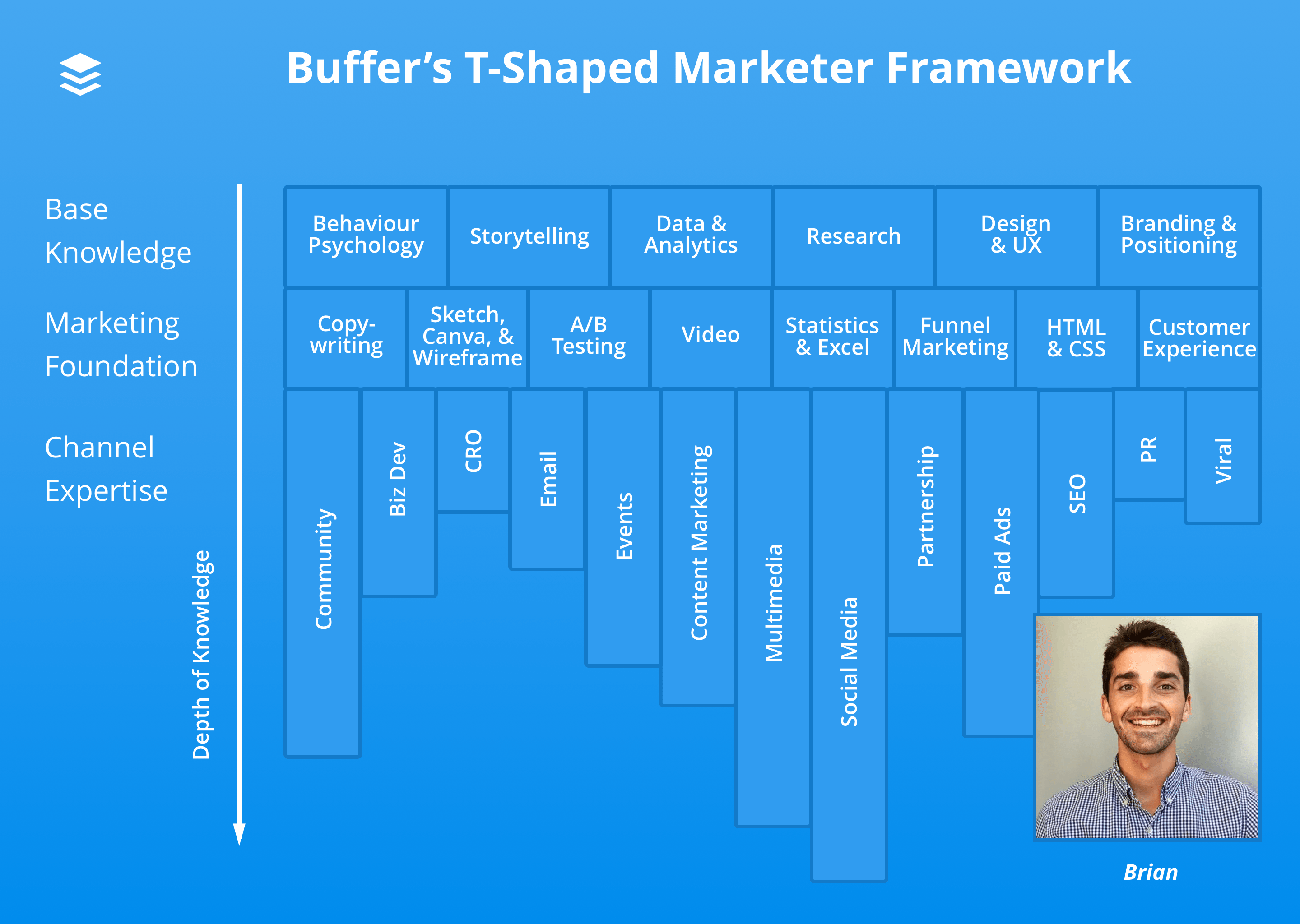
Hailley, PR and Communications Strategist
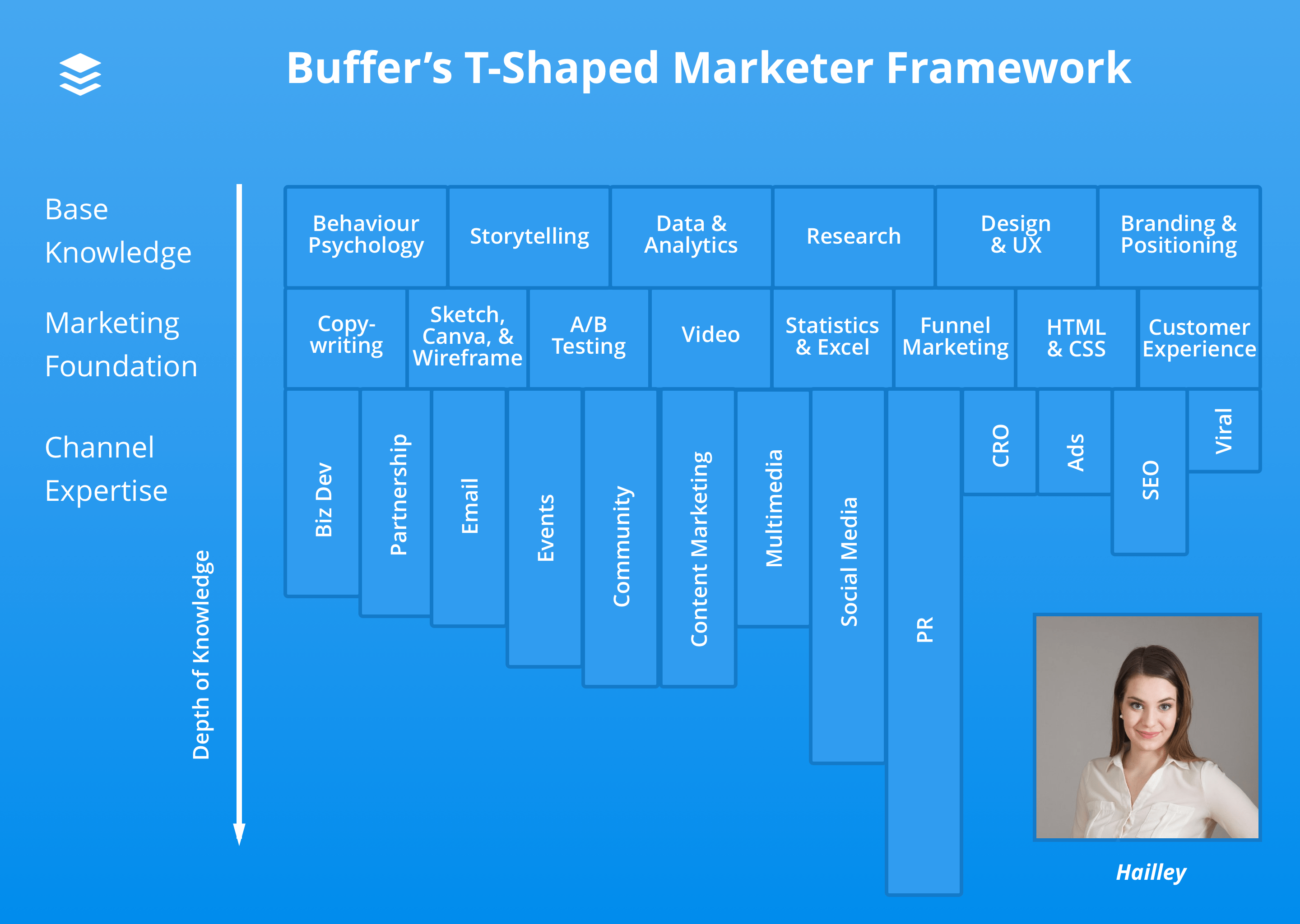
Mike, Product Marketer
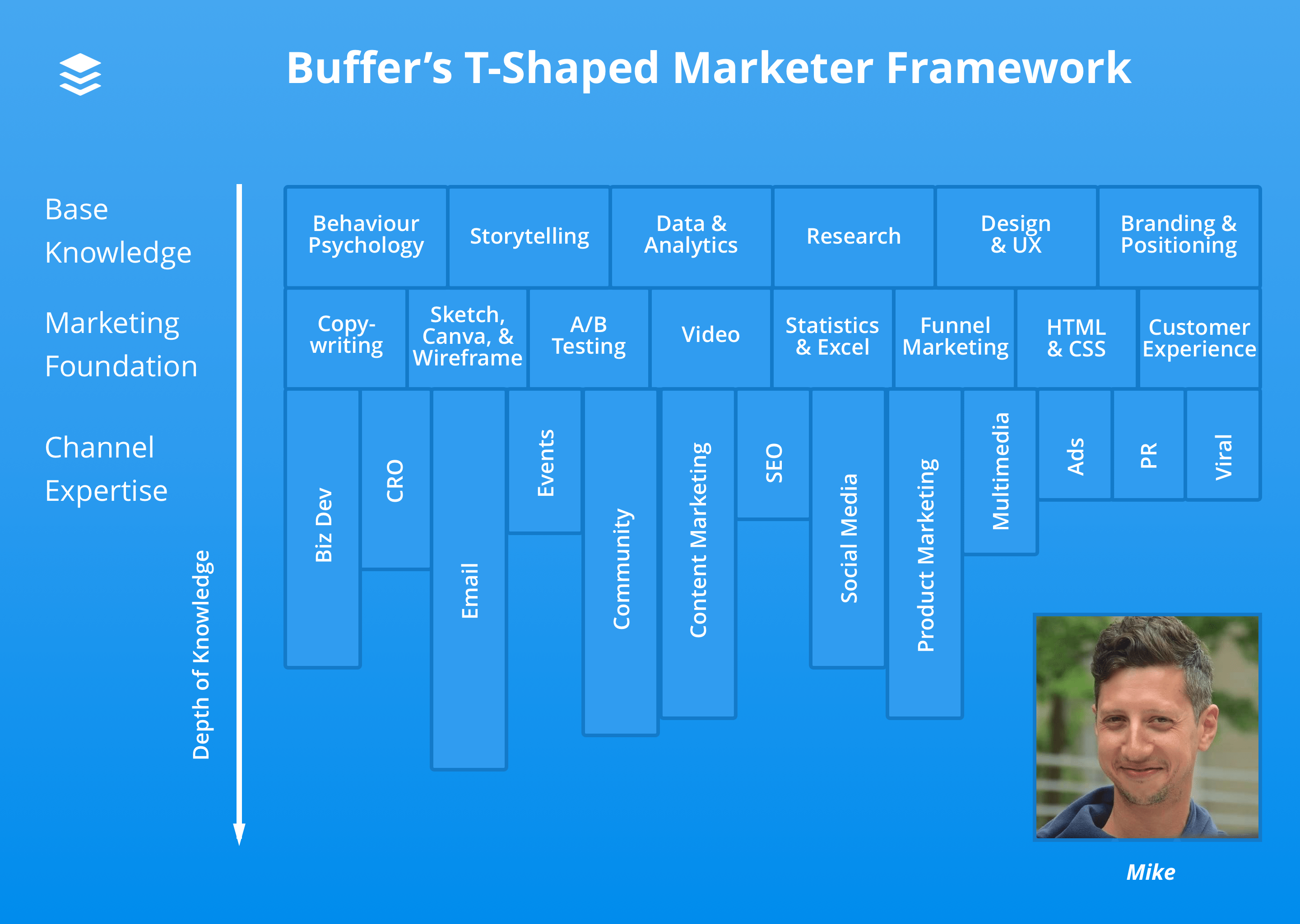
Spencer, Growth Marketer
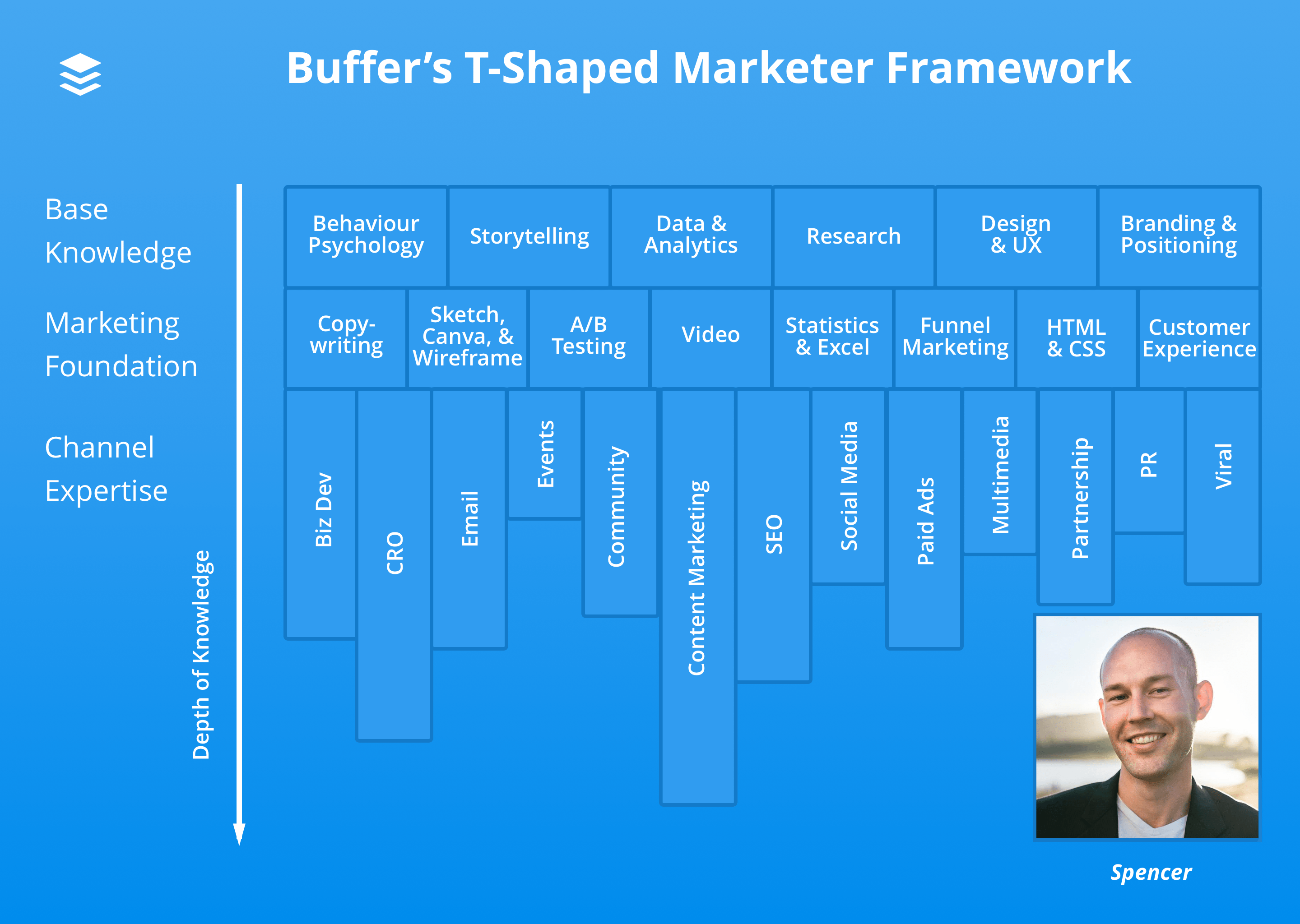
How to level up your T-shaped marketer skills
Of course, once you know where to head with your growth as a marketer, one of the next questions to ask would be how to get there. Fortunately, there are a ton of resources on most any marketing skill you could hope to achieve. Here’re a few of the resources we’ve found helpful as we’ve leveled up in all the different areas of a Buffer T-shaped marketer.
Base knowledge
Behavior Psychology
Knowledge in this area helps you better understand why people do what they do — a handy skill in most any job, particularly so when you’re eager to understand why people click, like, share, and buy.
- Blog: Cognitive Lode
- Book: Decisive by Dan and Chip Heath
- Book: Influence: The Psychology of Persuasion by Robert Cialdini
- Blog post: Putting Behavioral Psychology to Work to Improve the Customer Experience by McKinsey
- Blog post: 15 Psychological Studies That Will Boost Your Social Media Marketing by Buffer
- E-book: Hubspot’s Marketing Psychology Guide
Storytelling
We see storytelling and copywriting as different things. Storytelling is about knowing how to put together a narrative. Copywriting is about knowing the right words to use to express that narrative.
- Blog post: 11 Storytelling Formulas to Supercharge Your Marketing by Buffer
- Blog post: Master This Storytelling Technique to Create an Irresistible Content Series by Copyblogger
- Video: Pixar’s approach to storytelling (embedded above)
- Content series: Pixar in a Box from Khan Academy
- Blog post: The 6 Main Arcs in Storytelling by the Atlantic
Data and Analytics
Before you get into the weeds of Excel, Looker, SQL, etc., it’s essential to have a foundation in the general concept of data and analytics so that you know what’s possible to learn data and what makes for good data analysis.
- Video: Data-Driven Product Changes by Heavybit
- Book: Winning with Data by Tom Tunguz and Frank Bien
- Book: Naked Statistics by Charles Wheelan
Research
We were lucky to get in early with customer development at Buffer, which helped us cultivate a research culture. In specific marketing terms, research means checking with your audience to learn their experience, their problems, and their wishes. In more general terms, research is about putting a process to one’s curiosity.
- Book: Lean Customer Development by Cindy Alvarez
- Blog: Cindy Alvarez
Design and UX
We don’t expect Buffer marketers to be design pros (we’ve written several articles admitting we’re far from professionals). What we look for instead is a cultivated design eye: Do you have good taste? Can you identify the elements of design that lead to high quality?
- Blog: Canva’s Design School
- Email course: Making a Product Designer by Invision
Branding and positioning
This one could possibly also fit in “marketing foundation,” but I see branding as a bigger concept. We all have personal brands (whether we actively cultivate it or not). We position ourselves for new jobs and opportunities. There’s a basic knowledge here that transcends marketing.
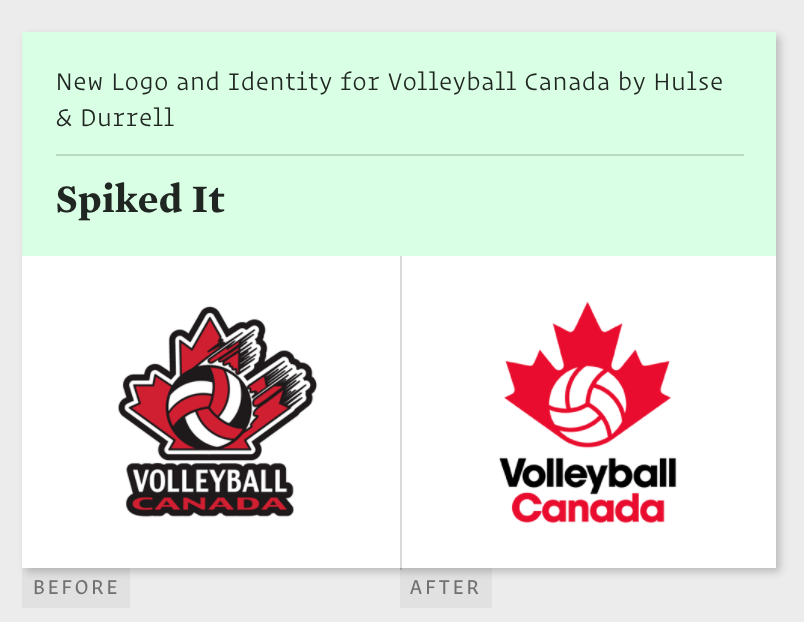
- Resource: Skype’s brand book
- Blog post: Gist’s guide to branding
- Resource: Ubuntu’s brand guidelines
- Blog: Brand New (example above)
- Blog post: Building Your Brand by Aaron Beashel
Marketing foundation
Copywriting
As I mentioned above, copywriting is about knowing the best words to use in order to get a message across.
- Blog: Copyhackers
- Blog: Copyblogger
- Book: Ogilvy on Advertising
- Blog post: If Don Draper Tweeted: The 27 Copywriting Formulas That Will Drive Clicks and Engagement on Social Media by Buffer
Sketch, Canva, and Wireframing
This is a step up from the base knowledge of “Design and UX.” Once you know the principles of design, how far can you get with creating something yourself? Sketch and Canva just so happen to be our tools of choice. Photoshop or another software might make sense for your marketing team.
- Content series: Getting Started with Sketch by Megumi Tanaka
- Email course: Design Workflow with Sketch
- My Canva profile (if you want to grab any templates)
- Blog post: A Beginner’s Guide to Wireframing by Envato
A/B testing
A/B testing can somewhat share a line with Conversion Rate Optimization (CRO), but we split it out on its own because we want all our marketing team to understand the basic principles behind A/B testing. First, do you have a testing mindset? (Which, put another way, could be “do you have a data and growth mindset?) Then second, if you think about testing, do you have the ability to bring basic scientific tests into your area of expertise? A/B testing is like our default setting for scientific tests.
- Blog post: 50 A/B Split Tests to Optimize Your Site by Sujan Patel
- Resource: The Complete Guide to A/B Testing by VWO
- Resource: A Beginner’s Guide to A/B Testing by KISSmetrics
- Blog post: How we lost (and found) millions by not A/B testing by Basecamp
Video
For many companies, video is a channel all its own. For us, video is such a big part of the social media marketing we do that it just makes sense for us all to be well-versed with what it takes to create a compelling video and be confident on camera.

The Down and Dirty DIY Lighting Kit | Wistia Learning Center
- Blog: Animoto
- Resource: The Wistia Library
Statistics and Excel
This is the next step beyond data and analytics. We’d love for everyone on the team to be able to put together a solid spreadsheet to track numbers and goals.
- Blog post: 10 Useful Google Spreadsheet Formulas You Must Know by Woorkup
- Blog post: Take Back Your Time With These 10 Ready-Made Spreadsheet Templates (And Our Top Tips and Time-Savers) by Buffer
- Blog post: 9 Free Microsoft Excel Templates to Make Marketing Easier by HubSpot
- Website: Stack Overflow’s “Excel” tag
Funnel marketing
How does a customer become a customer? This feels like something it’d be great for all on the marketing team to know, even if they only have a particular impact on one portion of the funnel.
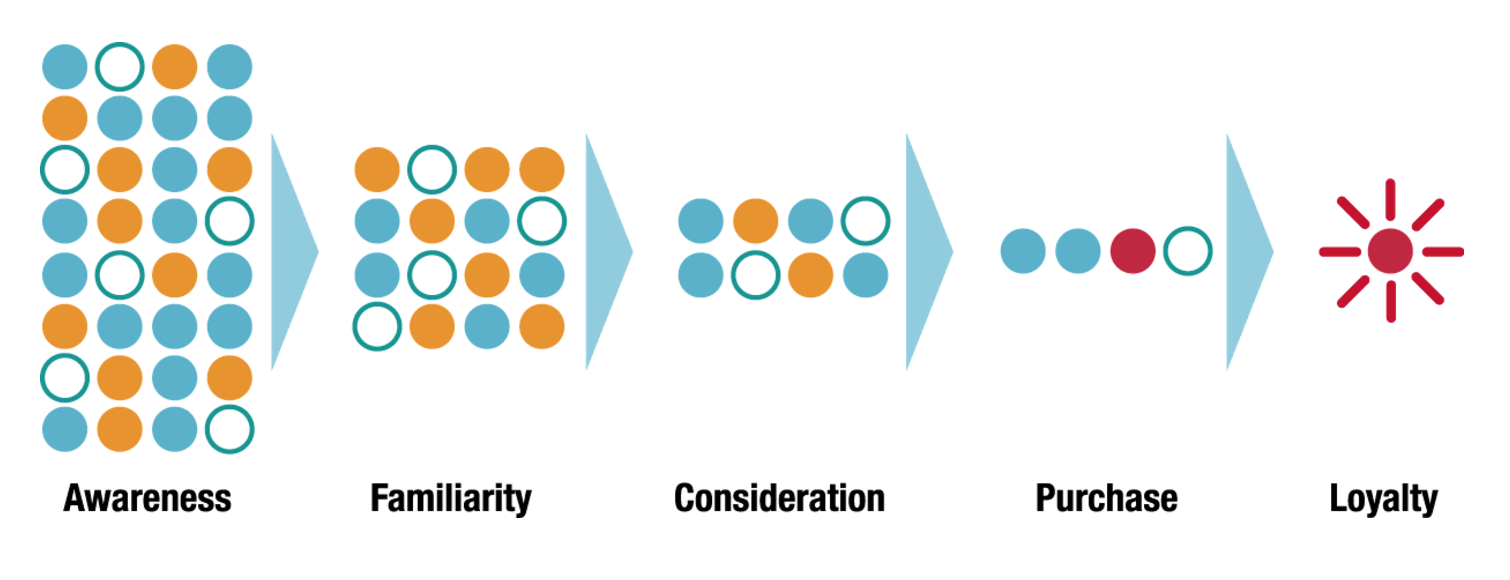
- Video: Building a Growth Machine by Brian Balfour
- Blog post: The consumer decision journey by McKinsey (see image above)
- Blog post: The Steps You Need to Define the Stages of Your Sales & Marketing Funnel by HubSpot
HTML and CSS
This level of code knowledge can come in handy in so many places: blog posts, landing pages, email design, just to name a few.
- Community: Stack Overflow
- Website: Treehouse
- Tip: Right-click and choose “View Source” or “Inspect Element” to see how any website is built
Customer experience (CX)
CX is a big part of Buffer as a company, which is why we emphasize it for our marketing team. This can look a number of different ways: for instance, hopping into the inbox to answer support tickets or thinking through the potential customer impact on launches, content, etc.
- Podcast: Support Ops
- Blog: HelpScout
Channel expertise
Biz Dev
Business development is the strategic relationship-building of key people and companies. For instance, at Buffer, if you were in Biz Dev you’d probably network with folks at Twitter, Facebook, Apple’s iOS store, etc.
- Book: How to Win Friends and Influence People by Dale Carnegie
- Blog post: Corporate Development 101: What Every Startup Should Know by OnStartups
- Slidedeck: Biz Dev 101: An Interactive Workshop on How to Get Deals Done
Community
Community is the process of connecting people with people, with the common denominator being Buffer.
- Blog: CMX Hub
- Book: Buzzing Communities by Richard Millington
CRO
This can also be classified as bottom-of-the-funnel marketing. The goal here is to improve conversion rates by lots of different avenues: landing pages, CTAs, ads, content, and more.
- Blog: ConversionXL
- Blog post: Conversion: The Most Important Internet Metric of All (Revisited) by Above the Crowd
Email marketing may include one-off campaigns, daily newsletters, lifecycle campaigns, and a lot more. In addition to being good at the content and conversion of emails, an email expert also knows the ins and outs of deliverability, ESPs, and a lot of other technical bits that are unique to email.
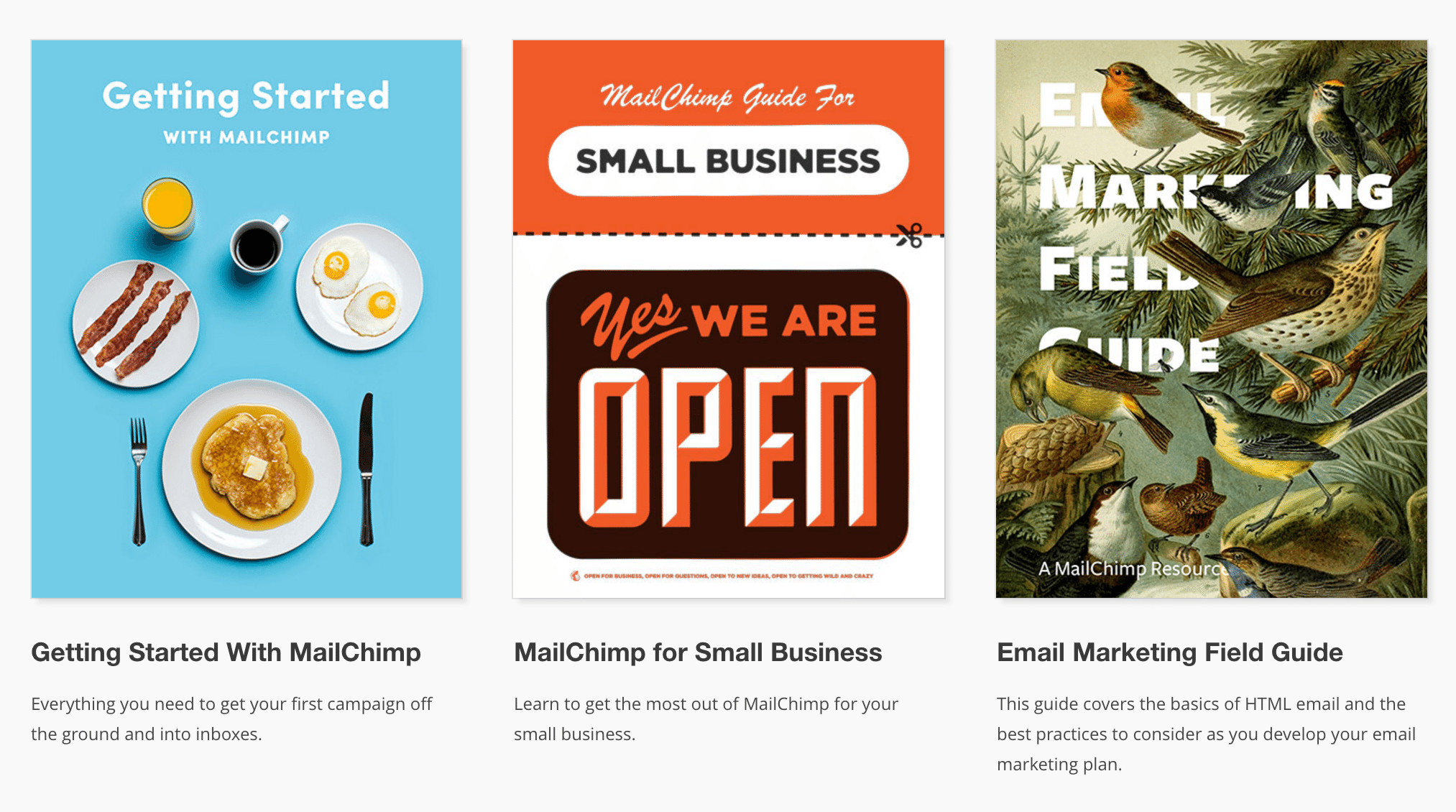
- Blog and podcast: Litmus
- Ebooks: Mailchimp library (seen above)
Events
An events expert can do everything from a meetup to a conference and tie back the event efforts to business impact.
- Ebook: 9 Simple Steps to Master Social Media for Events by Eventbrite
- Blog post: The Disneyland Effect: How to Plan a Successful Conference by Marketing Insider Group
- Podcast episode: Top Strategies for Taking Your Online Community Offline with Marketing Events – w/ Stefanie Grieser of Unbounce
Content marketing
Content marketing is primarily about blogging, though the true definition of content extends to anything you might create. More and more, the “anything” seems to fit on the blog as well: video, audio, slideshows, etc.
- Blog: Grow and Convert
- Blog post: The All-in-One Content Marketing Playbook for Startups by Copyhackers
- Slidedeck: Content Marketing Lessons from 10 Years and 41 Million Visits
- Slidedeck: Why Content Marketing Fails
- Blog post: The 51 Best Writing Articles I’ve Ever Read by Buffer
SEO
This is anything to do with search engine optimization, both the content/strategy side and the technical side.
- Blog: Moz
- Videos: Whiteboard Friday
- Blog post: This SEO Checklist = 48.7% More Organic Traffic [Case Study] by Backlinko
- Blog post: Rand Fishkin’s 5 Simple Experiments for Improving SEO Health by Unbounce
Multimedia
For us, a multimedia channel expert shows a deep skill with podcasting and video production. They can create both types of media as well as put together a multimedia strategy based on business goals and existing content.
- Blog post: How I Built a #1-Ranked Podcast With 60M+ Downloads by Tim Ferriss
- Blog post: Podcasting for the Creative-Minded: How to Avoid Yet Another Talking Head Show by Jay Acunzo
- Blog post: Podcast is the New Blog by 500 Startups
- Inspiration: Gary Vaynerchuk’s Facebook page
Paid ads
Most often when we talk about paid ads, we refer to social media advertising — Facebook, Instagram, Twitter, Pinterest, etc. However, a paid ads expert may also be adept at search engine marketing (SEM), media sponsorships, and banner and display ads.
- Resources: Adspresso Guide
- Blog post: 7 Advanced Tactics Pro Facebook Marketers Use to Boost Conversions by Copyhackers
- Podcast: Perpetual Traffic
Partnerships
For partnerships, we define this as someone who builds mutually beneficial relationships with peer companies, in order to drive a marketing objective. It’s a different flavor of biz dev: Biz dev is more focused on necessary networking for business growth, whereas partnership marketing is more focused on ad hoc collaborations for marketing objectives.
- Blog post: Co-Marketing: How to Reach New Customers With Strategic Partnerships by Shopify
- Blog post: What Is Co-Marketing? A Guide to Co-Branding Marketing Campaigns by HubSpot
- Podcast episode: Marketing Partnerships: How to Expand Your Reach with Content Collaboration by Social Media Examiner
PR
PR is accountable for driving interest and mentions for the brand. At Buffer, this includes press outreach, inbound PR, syndication, and communications.
- Blog post: 22 PR Tools and Resources by Brandwatch
Social media
I like the way Gary Vaynerchuk describes his work as the clouds and the dirt. He wants to be comfortable both at the highest strategic level and at the most tactical, on-the-ground level. This is true of someone who shows social media expertise.
- Blog: Buffer
- Blog: Social Media Examiner
- Book: Jab, Jab, Jab, Right Hook by Gary Vaynerchuk
Viral marketing
The outcome of viral marketing is that customers are selling your brand for you. There are a lot of different levers that can make this happen, not the least of which is a referral or loyalty program, as well as a deep understanding of virality, psychology, and network effects.
Other: International marketing, product marketing, mobile marketing.
The list of channels could go on and on. A couple others that come to mind include international marketing (strategically reaching an audience beyond your primary audience) and mobile marketing (iOS, Android, apps, etc.).
Advice on building your skills and choosing an expertise
For anyone new to marketing or excited to grow as a marketer, I feel there’s a lot of potential in a framework like this, no matter the specific boxes or stems.
Here’s how I tend to think about career growth.
1. Career planning for digital marketers is really hard.
Things change. Needs arise. Channels come and go. The most valuable skill to have is probably not anything like writing or video or networking but rather plain ol’ flexibility!
2. Balance what you enjoy, what you’re good at, and what your team needs.
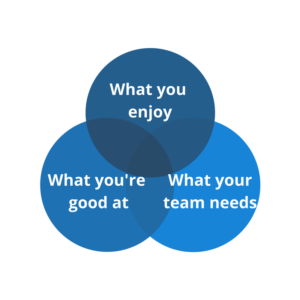
We use this Venn diagram to speak about how Buffer teammates move between roles on the team. Often, we’ve found there to be a varying combination of these three factors pulling someone to do a job. I’d suggest factoring in each of these when choosing a channel to grow into.
3. Go deep on two or more channels.
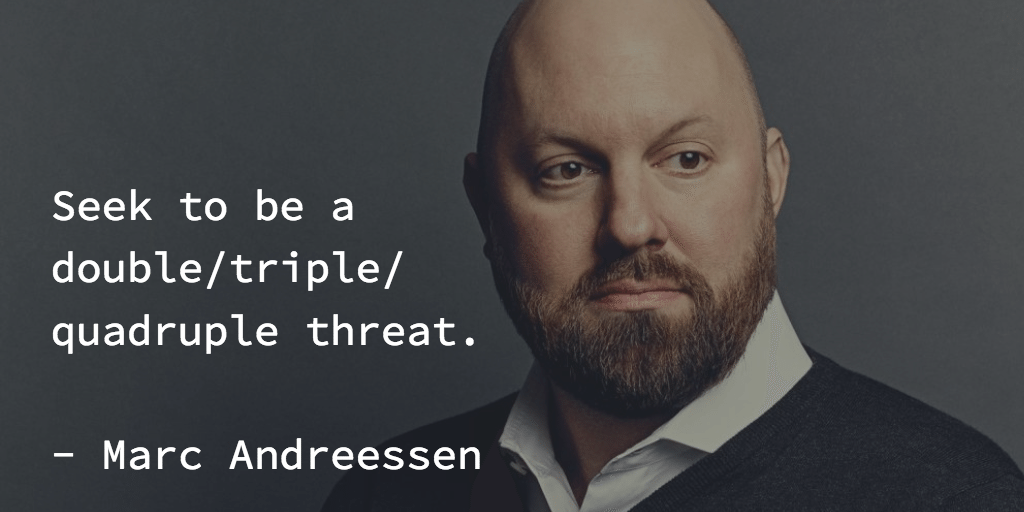
A single skill at a very deep level can be really valuable to have. The tricky thing I’ve observed is that depth is more highly valued at larger companies. A five-person marketing team likely won’t have the need for an SEO expert whose primary contribution is SEO. A five-person marketing team will need someone who can do two or more channels well (and can do lots more well enough).
Figure out the size of team you want to be part of, then build your skills accordingly.
4. Aim for rare and unusual combinations.
Capitalism rewards things that are both rare and valuable. You make yourself rare by combining two or more “pretty goods” until no one else has your mix…
This is a Marc Andreessen quote I love (there’s a bunch more in his book of blog posts, which you can download for free).
Have you ever met someone who’s great at paid ads and events? What about content and business development? Those are rare combos. Combining these somewhat disparate skills can make for a really attractive resume as you search out jobs in the future.
5. Choose an emerging channel.
If you are just starting your digital marketing career and have many years ahead of you, I highly suggest leaning towards emerging channels. Four years ago the emerging channels would have been Facebook and content marketing.
Emerging channels today would likely be data, artificial intelligence, customer experience, and engineering-as-marketing. If you can get in on the ground floor of these, you’ll be well positioned when they become more widely recognized.
Over to you
I hope this overview of T-shaped marketers can help you find your next skill to learn or direction to grow. It’d be fantastic to hear your thoughts!
- What do you see your marketing career path looking like?
- Anything you’d add to our T-shaped list?
Image sources: Unsplash
Try Buffer for free
190,000+ creators, small businesses, and marketers use Buffer to grow their audiences every month.



